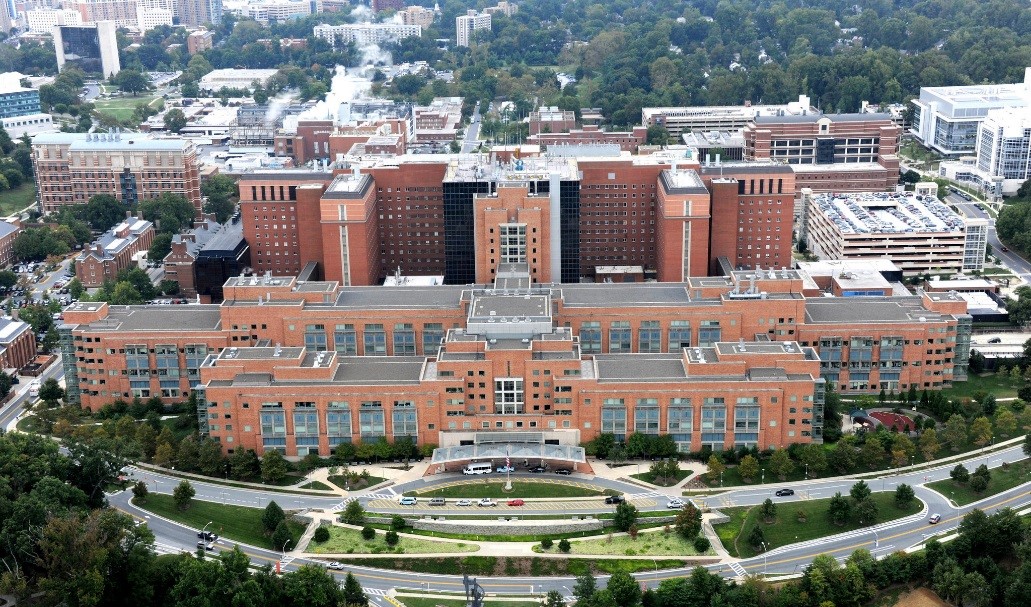
Dear Colleagues:
The main NIH campus, located in Bethesda, Maryland, is home to thousands of scientists spread throughout more than 50 buildings. Most prominent is the Clinical Center, the world’s largest hospital dedicated to clinical research. Known as Building 10, some refer to it as the "House of Hope." It’s been the birthplace of many "firsts": cancer patients received the first chemotherapy to treat tumors, scientists performed the first human gene therapy tests, surgeons first successfully replaced the heart’s mitral valve, and researchers found early success with the first anti-viral drug for HIV/AIDS.
This world-renowned facility is currently featured in a Discovery Channel documentary called First in Human. The three-part series captures the real-life experiences of patients and their caregivers, doctors, researchers and staff at the Clinical Center. The documentary, which is narrated by Jim Parsons (The Big Bang Theory, Hidden Figures), highlights the challenges faced in diagnosing and treating diseases.
Much of the research NIAMS conducts in our Intramural Research Program (IRP) is anchored in the Clinical Center. Here are a few examples of this work, often performed in collaboration with other Institutes and partners, that are translating science into better diagnostics, treatments and prevention strategies.
- Lupus treatment: The autoimmune disease lupus can cause inflammation and damage to many tissues in the body, including the joints, skin, kidneys, heart, lungs, blood vessels and brain. The NIAMS IRP, in partnership with scientists in other NIH Institutes, carried out landmark clinical trials to establish the immune suppressant cyclophosphamide as the standard of care for lupus patients with inflammation of the kidneys, known as lupus nephritis. Thanks in large part to this research, what was once a terminal disease has now become a chronic condition for many affected patients.
- Autoinflammatory diseases: In this class of conditions, the innate (inborn) immune system becomes activated and triggers unneeded inflammation. Normally, the inflammatory response helps fight infections, but the prolonged inflammation that occurs in these diseases can damage the body. NIAMS researchers and other NIH intramural investigators, working alongside patients in the Clinical Center, have uncovered genetic defects that underlie autoinflammatory conditions known as SAVI, DIRA, and CANDLE. They’ve also identified life-changing treatments for rare and debilitating autoinflammatory diseases, such as NOMID.
- Development of tofacitinib: In the early 1990’s, NIAMS IRP Scientific Director Dr. John J. O’Shea’s research team identified a group of proteins called Janus kinases that are important in regulating the human immune system. This discovery led to the idea that drugs blocking Janus kinases would suppress the immune system and might protect against the damaging inflammation of rheumatoid arthritis (RA) and certain other autoimmune diseases. A public-private collaboration between NIH and the pharmaceutical company Pfizer led to approval of the drug tofacitinib by the U.S. Food and Drug Administration in 2012 for the treatment of moderate to severe RA. NIAMS scientists in the Clinical Center are now carrying out research exploring use of this drug for treatment in other inflammatory diseases such as lupus.
- Community Health Clinic (CHC): NIAMS established the CHC in 2001 as a collaborative effort between the local underserved community and the Institute. Patients from the diverse multilingual population of Washington, DC, as well as the Virginia and Maryland suburbs, are referred for evaluation by their primary care physician. The clinic offers free access to specialists, health information, and referral to clinical studies for the prevention and treatment of arthritis, lupus and other rheumatic diseases. The CHC moved to the Clinical Center last year, facilitating easy access to bilingual staff and state-of-the-art facilities. Patients receive care in the full-service clinic from a team that includes staff in the NIAMS rheumatology fellowship training program. The CHC has enrolled more than 2,500 patients and provided nearly 17,000 patient visits since its inception.

The new documentary, First in Human, provides an unprecedented look at both the successes and setbacks that are a part of developing new medicines. More than 1,000 staff and 100 patients voluntarily participated in the production. I encourage you to share information about our ongoing clinical trials, both in the NIH Clinical Center and conducted by our extramural researchers around the country, and to take a moment to thank all the volunteers who participate in clinical trials.
Stephen I. Katz, M.D., Ph.D.
Director
National Institute of Arthritis and Musculoskeletal and Skin Diseases
National Institutes of Health
Resources to share:
- NIH Clinical Trials and You Basic information on clinical trial participation
- Why do researchers do different kinds of clinical studies? en español (PDF infographics)
- Patient Recruitment at the NIH Clinical Center Research participants include both healthy volunteers and patient volunteers
- ClinicalTrials.gov Registry and results database of publicly and privately supported clinical studies of human participants conducted around the world
